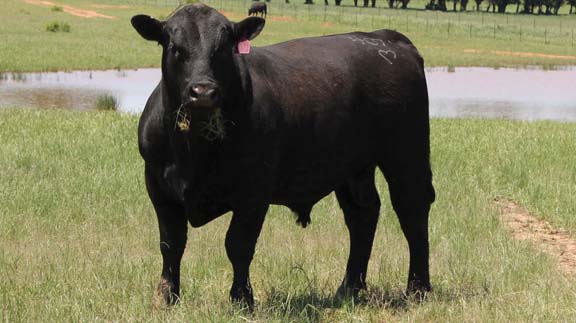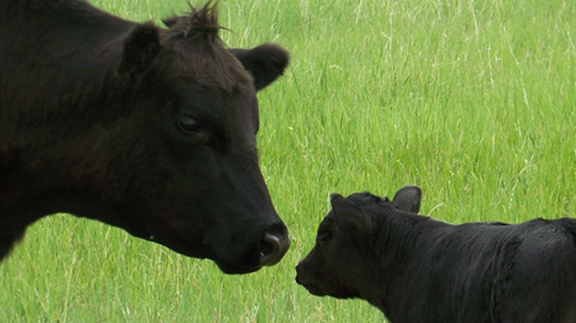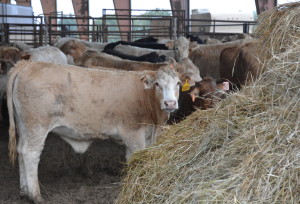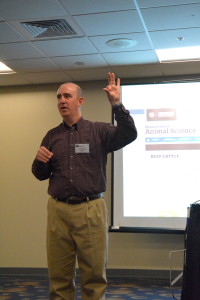Farm & Ranch
[AgriLife Today] Marketing options for cattle discussed at Blackland Income Growth Conference

By: Blair Fannin
Writer: Blair Fannin, 979-845-2259, [email protected]
Contact: Dr. Jason Banta, 903-834-6191, [email protected]
WACO – From traditional livestock auctions to online sources, cattle producers have a variety of options to choose from when marketing cattle, according to a Texas A&M AgriLife Extension Service beef cattle specialist.
Dr. Jason Banta, Texas A&M AgriLife Extension Service beef cattle specialist, said the biggest impact on income in a cattle operation is percentage of calves weaned. Other pieces of the equation include how many pounds the calves weigh and price received per pound. (Texas A&M AgriLife Extension Service photo by Blair Fannin)
Dr. Jason Banta, beef cattle specialist at the Texas A&M AgriLife Research and Extension Center in Overton, gave a broad overview of marketing options at the recent Blackland Income Growth Conference in Waco.
Banta said the biggest impact on income in a cattle operation is percentage of calves weaned. Other pieces of the equation include how many pounds the calves weigh and price received per pound.
“Condition of cows at calving time has the biggest impact on pregnancy rates,” Banta said. “You want those cows to be at a body condition score of five or better.”
Genetics also play an important role as well as input costs. Cull cows and cull bulls account for 10 to 15 percent of producers’ income.
“There’s value in these animals, and we need to market these animals to maximize the value,” Banta said.
There are several marketing channels, such as traditional livestock auction markets and online sources where a producer can post a classified ad.
For feeder calves and stocker cattle, Banta said producers can use livestock auction markets or sell through special preconditioning sale venues.
“You’d be surprised how far you can haul some cattle and get them into a preconditioning sale. The key is to go with one that has a good reputation to capture that premium.”
There are also video auction services as well as having someone come to your ranch and buy direct.
Dr. Jason Banta, beef cattle specialist at the Texas A&M AgriLife Research and Extension Center in Overton, gave a broad overview of cattle marketing options at the recent Blackland Income Growth Conference in Waco. (Texas A&M AgriLife Extension Service photo by Blair Fannin)
“Out of all of these options, it has to fit your operation and knowledge base,” he said.
When using auction markets, producers who have 15 to 30 better quality calves can call the barn ahead of time so the barn can advertise and help better market the calves.
“Some will let you pull tags early,” Banta said. “This is a good way to get a group of calves you have and sell them together before buyers who might be looking for a good group. They like this instead of having to pick them out one by one throughout a sale day or at multiple sales.”
Factors affecting the selling price of calves include color. Banta advised against producing calves with spots or paint colors. However, replacement females with stripes, such as a Braford cross, will bring a premium.
“We sell cattle on perceived breed type,” he said. “There are significant discounts if you have more influence of a breed that is not wanted by order buyers.”
Recommendations include no more than one-quarter Bos Indicus, at least one-quarter British and no more than one-half Continental.
“The industry wants medium to large frame cattle,” he said.
Banta said time of year can also affect prices paid. Spring typically brings some of the higher prices for weaned calves and cull cows, while fall will bring the lowest since many cattle operations are selling at this time.
-30-
Find more stories, photos, videos and audio at http://today.agrilife.org
Farm & Ranch
Managing Show Cattle Through The Winter

By Heather Welper
Husband and wife duo, Heather and Calvin Welper, are the Co-Owners and Operators or Two C Livestock, located in Valley View, Texas.
The pair’s operation has a show cattle focus where they raise and sell purebred heifers of all breeds and club calf Hereford steers.
When it comes to show cattle, the Welpers know a thing or two including how to prepare for the cold winter months and the Texas major show season run.
To read more, pick up a copy of the November edition of North Texas Farm & Ranch magazine, available digitally and in print. To subscribe by mail, call 940-872-5922.

Farm & Ranch
Double M Ranch & Rescue

By Hannah Claxton, Editor
As the sun rises each day, so do the dozens of mouths that Meghan McGovern is responsible for getting fed. Rather than the sounds of a rooster crowing, McGovern hears the bellows and bleats of a variety of exotic deer, the chortle of kangaroos, the grunts of water buffaloes, and the chirps of a lemur.
Nestled against the banks of the Red River, the Double M Ranch and Rescue, with its high game fences and deer sprinkling the landscape,s its in stark contrast to the surrounding ranches.
“Having deer is kind of like eating potato chips- you can never actually have just one,” said McGovern with a laugh.
McGovern has several herds to take care of- fallow deer, axis deer, water buffalo, goats, and bison. In smaller numbers, there’s also a few kangaroos, a lemur, a potbelly pig, a pair of zebras, a watusi, and a few horses.
To read more, pick up a copy of the November edition of North Texas Farm & Ranch magazine, available digitally and in print. To subscribe by mail, call 940-872-5922.

Farm & Ranch
Acorn Toxicity

By Barry Whitworth, DVM, MPH
With the prolonged drought, most pastures in Oklahoma end up in poor condition. With the lack of available forage, animals may go in search of alternative foods.
If oak trees are in the pastures, acorns may be a favorite meal for some livestock in the fall. This may result in oak poisoning.
Oak leaves, twigs, buds, and acorns may be toxic to some animals when consumed.
To read more, pick up a copy of the November edition of North Texas Farm & Ranch magazine, available digitally and in print. To subscribe by mail, call 940-872-5922.

-

 Country Lifestyles2 years ago
Country Lifestyles2 years agoScott & Stacey Schumacher: A Growth Mindset
-

 Country Lifestyles8 years ago
Country Lifestyles8 years agoStyle Your Profile – What your style cowboy hat says about you and new trends in 2017
-

 HOME8 years ago
HOME8 years agoGrazing North Texas – Wilman Lovegrass
-

 Outdoor10 years ago
Outdoor10 years agoButtercup or Primrose?
-

 Country Lifestyles5 years ago
Country Lifestyles5 years agoAmber Crawford, Breakaway Roper
-

 Equine1 year ago
Equine1 year agoThe Will to Win
-

 Country Lifestyles9 years ago
Country Lifestyles9 years agoJune 2016 Profile – The man behind the mic: Bob Tallman
-

 Country Lifestyles8 years ago
Country Lifestyles8 years agoDecember 2016 Profile, Rusty Riddle – The Riddle Way






